Among the many arts and crafts created in Morocco by maalems, or master craftspeople, Moroccan tile work and ceramics is among the most skilled and beautiful.
Morocco’s ancient city of Fez is a center for these ceramic and tile workshops, although the cities of Safi and Meknes are also major centers. The work initially began in the 8th century and especially flourished in the 13th and 14th centuries. Almost all of the workshops have been family-owned for many generations. Many who do the work are family members, and many others not related by blood have also been employed by the same workshop for generations.
The opportunity to visit and tour Serghini Poterie des Fes in the city of Fez was a trip highlight. The sprawling complex, right in Fez’ ancient medina, is a stunning example of the how the craft is preserved and the wares remain both useful and desired artistically.
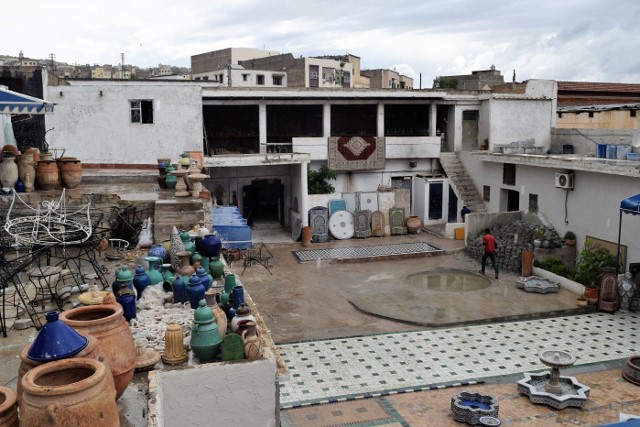
Through the workshop, different teams of artisans work, each specializing in tasks and type of production. The work is still most often handed down from generation to generation. Some work to prepare the clay. Others sit at the potters’ wheel, turning the clay into various pieces and others will paint the pottery. Another team will make tiles, others will paint tiles, and others will fire the work. Still others will create zeliij tile, and a vast array of work from this particular type of tile work.
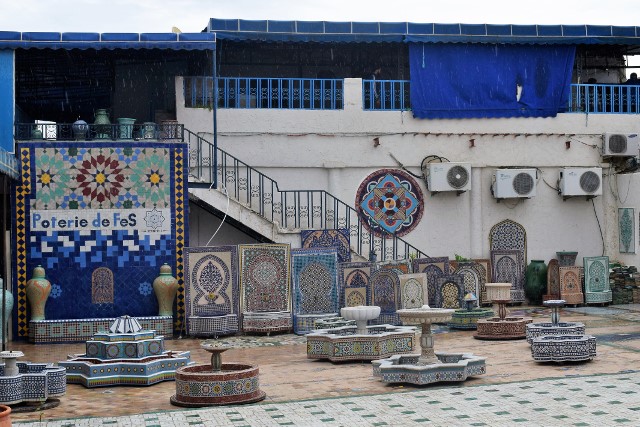
The Art and Skill of Moroccan Tile
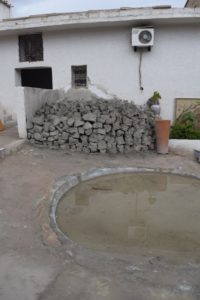 Every aspect of the process requires skill. The quality of the clay is very important, as are the preparation it undergoes before being formed into blocks that the potters will use to make turn or tile makers will form to make tile.
Every aspect of the process requires skill. The quality of the clay is very important, as are the preparation it undergoes before being formed into blocks that the potters will use to make turn or tile makers will form to make tile.
Artisan potters turn the pieces. At Serghini Poterie des Fes, these include vases and urns, bowls, dishes, and cups, candlesticks and more, each of many sizes, shape and function.
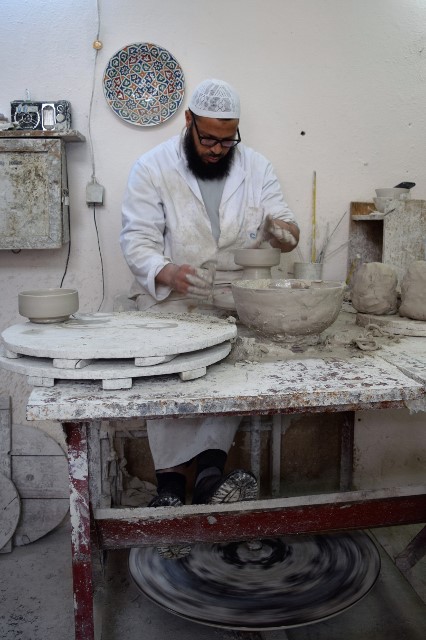
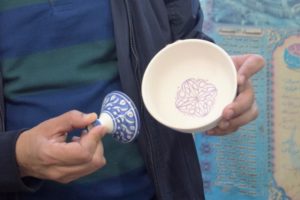 Designs are sometime stamped into the work before painting, but more often, designs are done by hand.
Designs are sometime stamped into the work before painting, but more often, designs are done by hand.
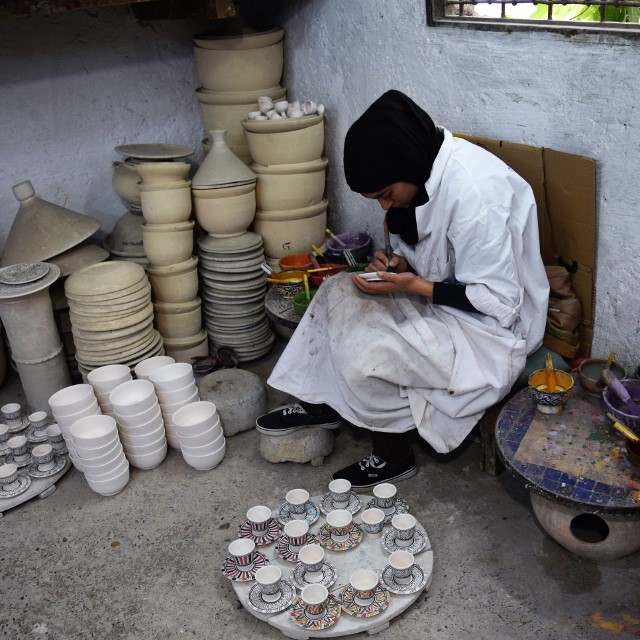
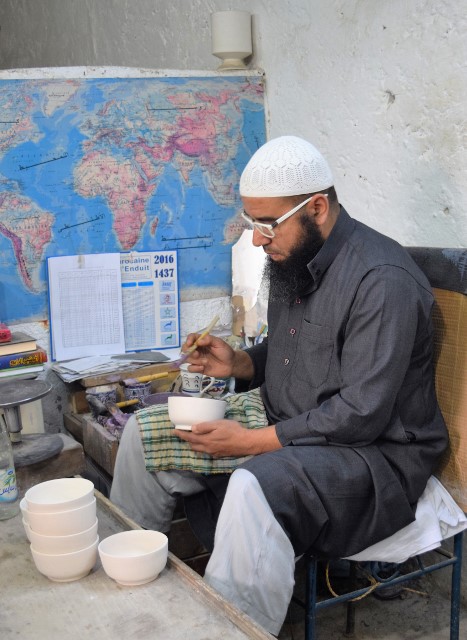
The pieces are fired twice, before painting and after, in kilns in a manner similar to how it’s been done since pottery was first created. The kilns are not electric, and instead have a unique beehive design that use olive pits left over from the oil pressing process for fuel.
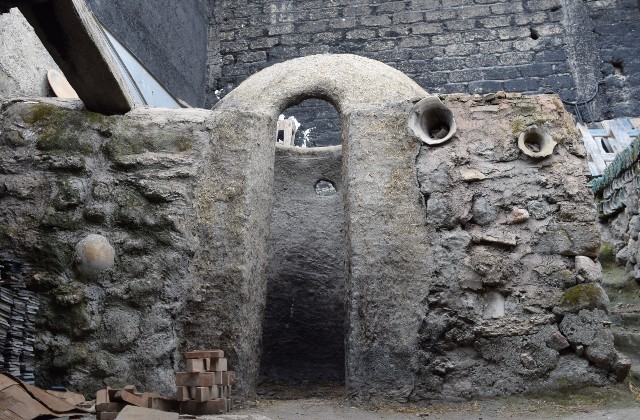
Finishing work is done for the pieces, if needed. To make a sink with a counter, for example, the bowl and framed counter are created, and then adhesive is used to seal the parts in place.

The finished products are beautiful and the possible patterns and colors are endless.
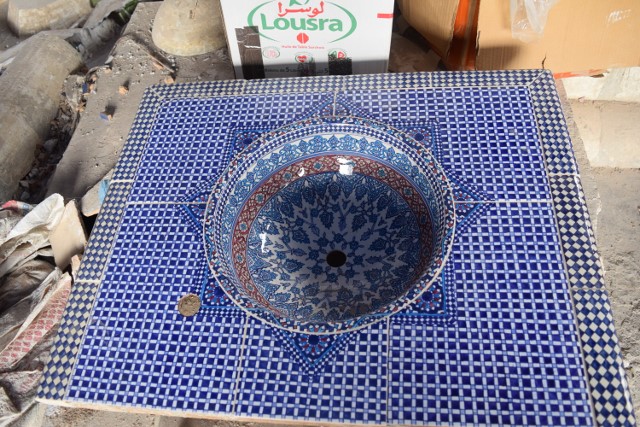
Zeliij Tile
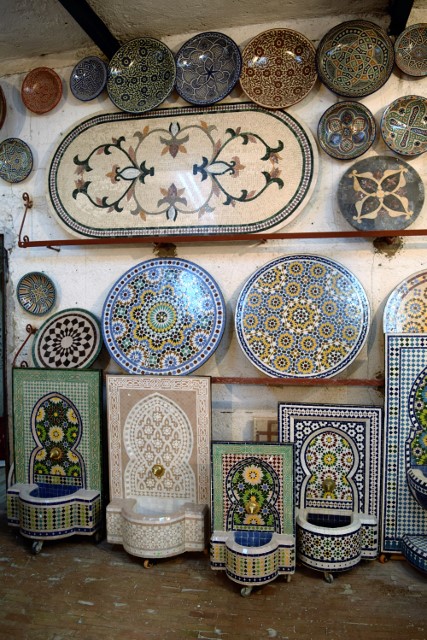 The most fascinating of the work, for me, is the creation of zeliij tile pieces and the works created from them. Combining traditional and historical artistry and mathematics, the work is especially skillful, time intensive and beautiful.
The most fascinating of the work, for me, is the creation of zeliij tile pieces and the works created from them. Combining traditional and historical artistry and mathematics, the work is especially skillful, time intensive and beautiful.
The making and craft of zeliij tile (also spelled zelige, zeliig or zelliij) is especially fascinating. Zeliij differs from mosaic in that mosaic is usually composed of random-sized pieces of various tiles to create a piece, whereas zeliij has a specific set of colored and shapes of tile and each tile is hand cut to that particular shape. The tiles are formed to create often elaborate geometric Moorish and Islamic patterns.
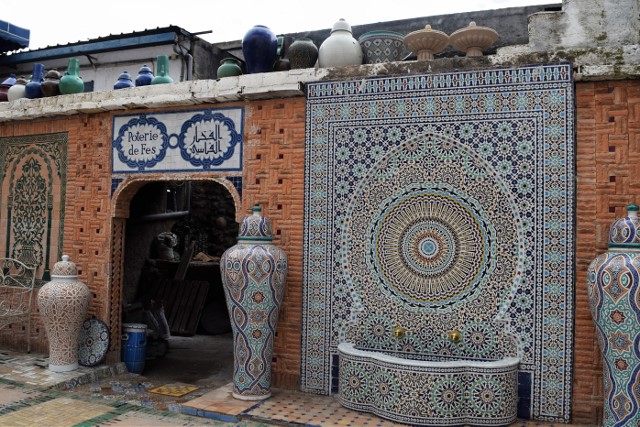
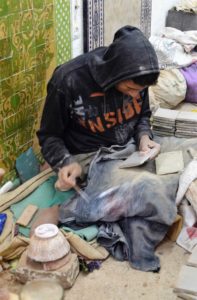 Patterns are traced onto the colored tile. There are 26 possible tile shapes. Each shape and color is steeped in Islamic symbolism and meaning.
Patterns are traced onto the colored tile. There are 26 possible tile shapes. Each shape and color is steeped in Islamic symbolism and meaning.
Zeliij maalems then meticulously uses a mallet-chisel to cut a shape out of the tiles, using only one or two preferred chisel types.
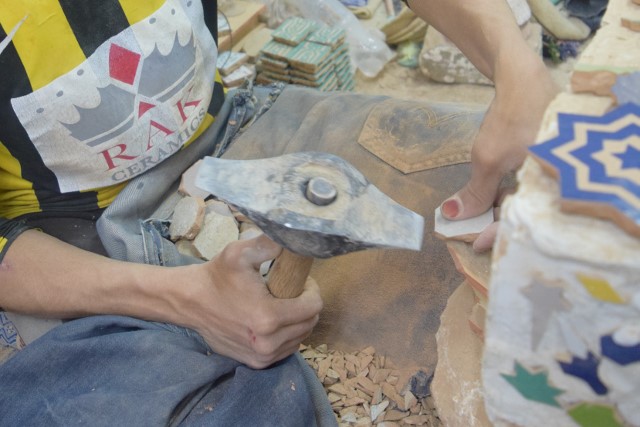
The tiles are cut with beveled edges, the backsides smaller than the finished fronts, so that the plaster or adhesive used after the pieces are assembled keep the tiles better in place, and also minimize space between the tiles.
The chisels, called menqach, are heavy. On our tour, we commented that the artisans must all have great upper body strength from the work. Our guide pointed out how the chisels are held against the leg and that helps distribute the weight and give control. This no doubt made some difference, but we still saw the physicality of the work, as well as the skill.
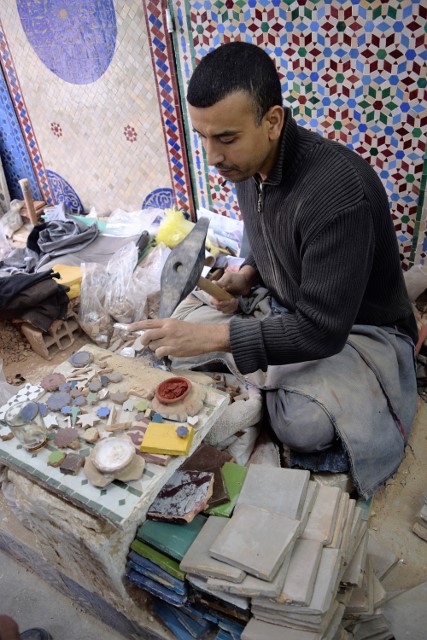
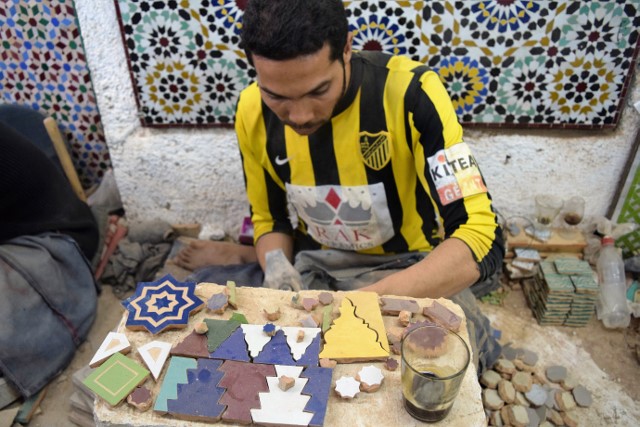
From these tiles, the finished work is created.
Larger pieces, such as fountains, may use a mold, in which the tile is laid, finished, colored side down, thousands of pieces creating the finished product. Adhesive (rather than concrete) will be used to seal the tile in place. The tiles are set close together and use only a minimal of grout.
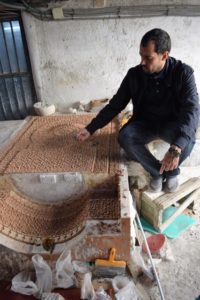

The Sales Showrooms
One showroom houses some of the oldest and best pieces. There are stunning examples of work often embellished with metal work and lapidary. The color and workmanship of these are amazing. Some of the pieces are hundreds of years old.
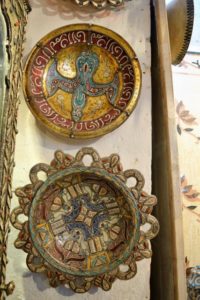
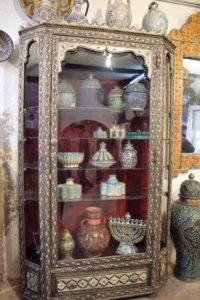
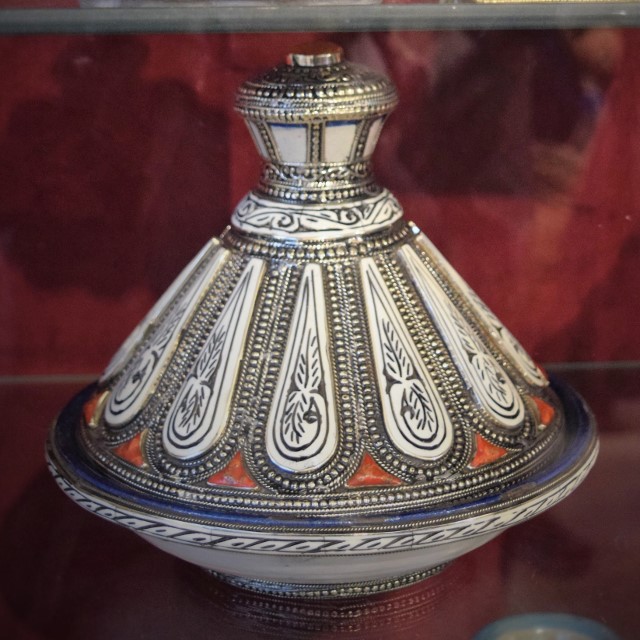
Other work for sale is available in numerous showrooms, special pieces and those suitable for everyday use, all beautiful and functional. Fountains and tables available. Interior and exterior work can be custom designed.
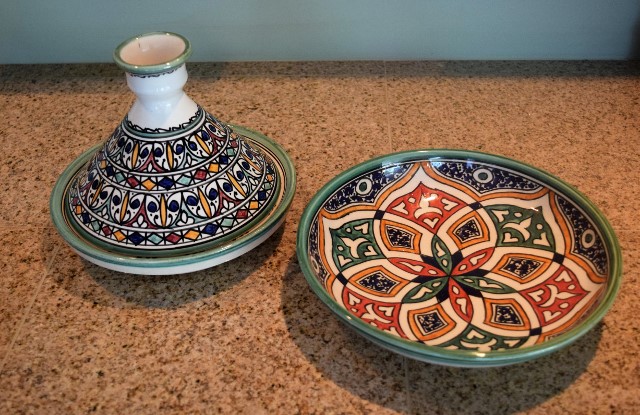 As a cook, the one souvenir I was intent on bringing home from my visit to Morocco was a tagine (also spelled, tajine), the Moroccan cooking vessel used to make stews that go by the same name.
As a cook, the one souvenir I was intent on bringing home from my visit to Morocco was a tagine (also spelled, tajine), the Moroccan cooking vessel used to make stews that go by the same name.
Once I settled on the size I wanted (a smallish, nine inch tagine, in this case), the search began for the color and pattern that most called my name. A salesperson took me through several rooms, up and down narrow stairways, to show me see what they had and I found the perfect green tagine, as well as a similarly colored bowl. Using both of these pieces make me happy.
A Timeless Art
Through the trip, examples of Moroccan tile work had me gawking, well, like a tourist. I’ve got a ridiculous number of photographs of the work seen throughout Morocco.
Fortunately, the work is found throughout the old medinas as well as in new architecture, including the Hassan II Mosque in Casablanca, the third largest mosque in the world, completed in 1993 with stunning tilework inside and out. It’s this respect for the art that ensures it won’t be lost.
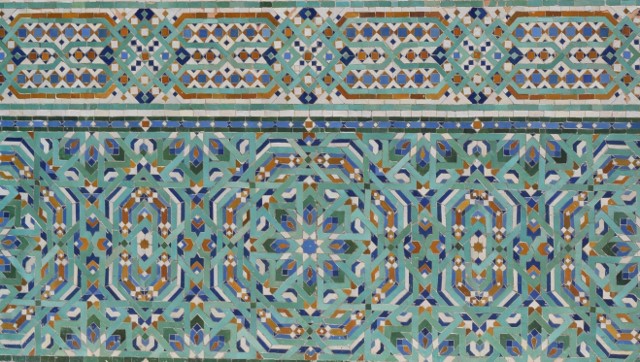
For More:
- Moroccan National tourism, https://www.muchmorocco.com/
- Close Line Projects’ YouTube Video, https://www.youtube.com/watch?v=SsQnXxlJ4iE
- Right here, at Confetti Travel Cafe: On Moroccan riads and on camping in the Sahara desert
- Overseas Travel Adventures (OAT), oattravel.com. I made part of this trip to Morocco with OAT. While I’ve always been an independent traveler, I’m attracted by the emphasis on getting to know the people and culture of a place and the lack of a single supplement for solo travelers. If you’re interested in learning more, providing this code when you book your trip (#002665715) will get us both a discount.
-All Photos by Nancy Zaffaro.

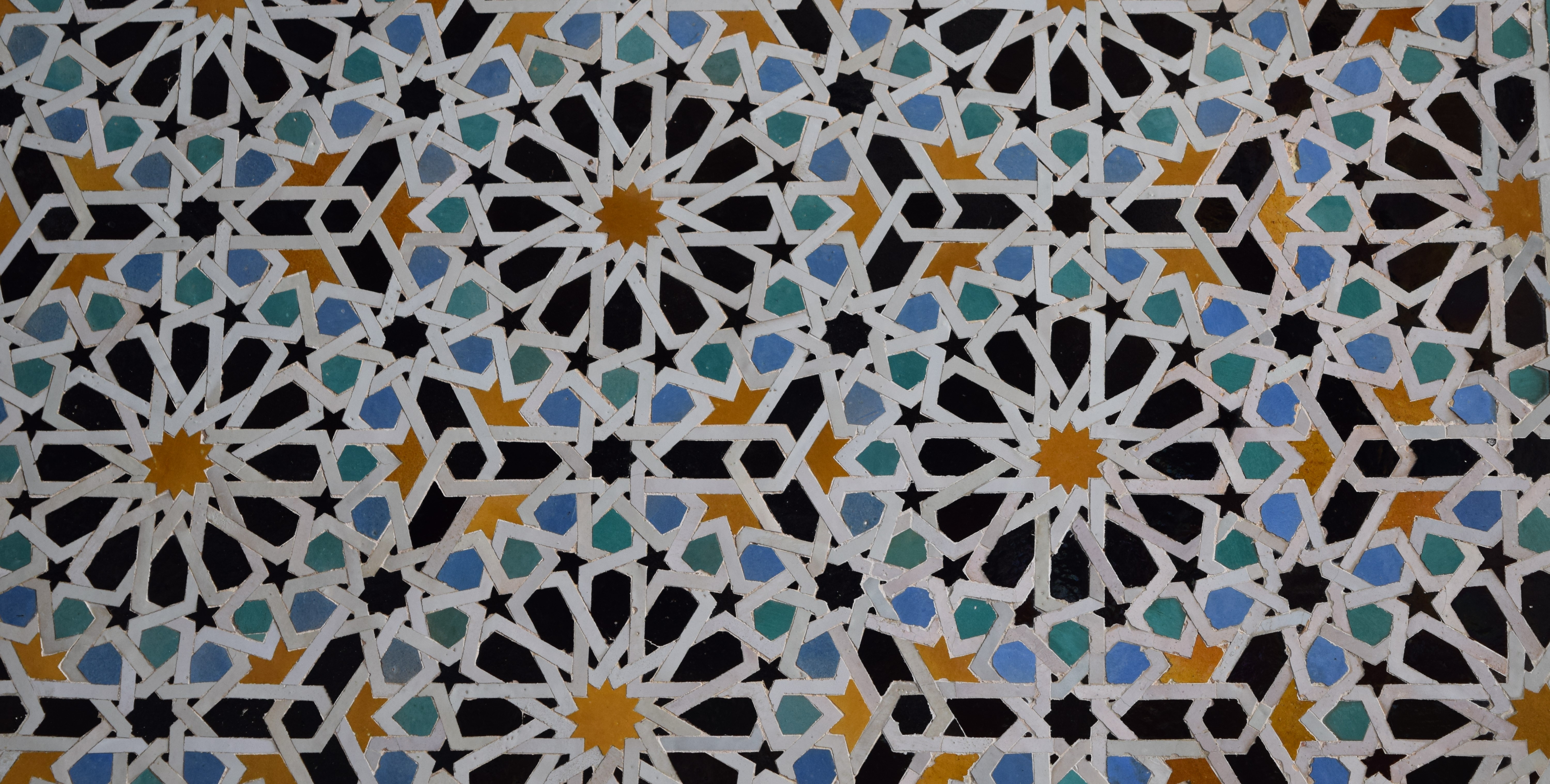

12 comments
Great job Nancy. It is fascinating to give to people detailed information about this very ancient work. I would like to share a little information , this work is at least 2000 years old , not only from 11th century as you mentioned. The justification is that Romans decorated their villas with tiles similar to the one we see now.
Thank you
Thank you so much, Abdel. You’re right, ceramic and tile work does date back much further. I was able to see some of the Roman mosaic floor tile work at Volubilis (an incredible site!), which dates back 2000 years ago. Was zeliij work done that long ago as well? So glad you commented.
Dear Nancy,
Thank you so much for sharing this article, it’s realy helpful and has a lot of informations about the history of Morocco.
Keep writing, you are doing a great job
I’m so glad you like the piece; thank you for your kind words. Feel free to share it with those who take your tours, of course. You live in an extremely beautiful country, with a very very rich history. I took a look at your tours and your story; fabulous! Continued success.
(And I encourage other readers to take a look too! You won’t regret traveling in Morocco!)
I love pottery and tile. I enjoyed reading this piece and loved your photos. How lucky you are to have brought home the beautiful pieces from the workshop where you saw them being made!
Thanks so much for your kind words! Yes, there is such art and skill to this work. We are always lucky to be able to travel!
Hey Nancy You doing great job.. Amazing article . thanks to sharing with us such good information. Keep Posting.
So glad you like! Sharing art and culture is a favorite writing topic, no doubt.
Amazing article full of value informations Thank you
Shokran, Morocco Holidays! I appreciate your kind comments. I very much enjoyed my visit to Morocco and learning about this tilework.
Best,
Nancy
Nice and grateful blog post, Thanks for sharing!
Shokran, Sarah,
So glad you like the article. I so so enjoyed and appreciated learning about this beautiful art. I enjoyed my visit to Morocco and hope to visit and write about it again!
Best,
Nancy